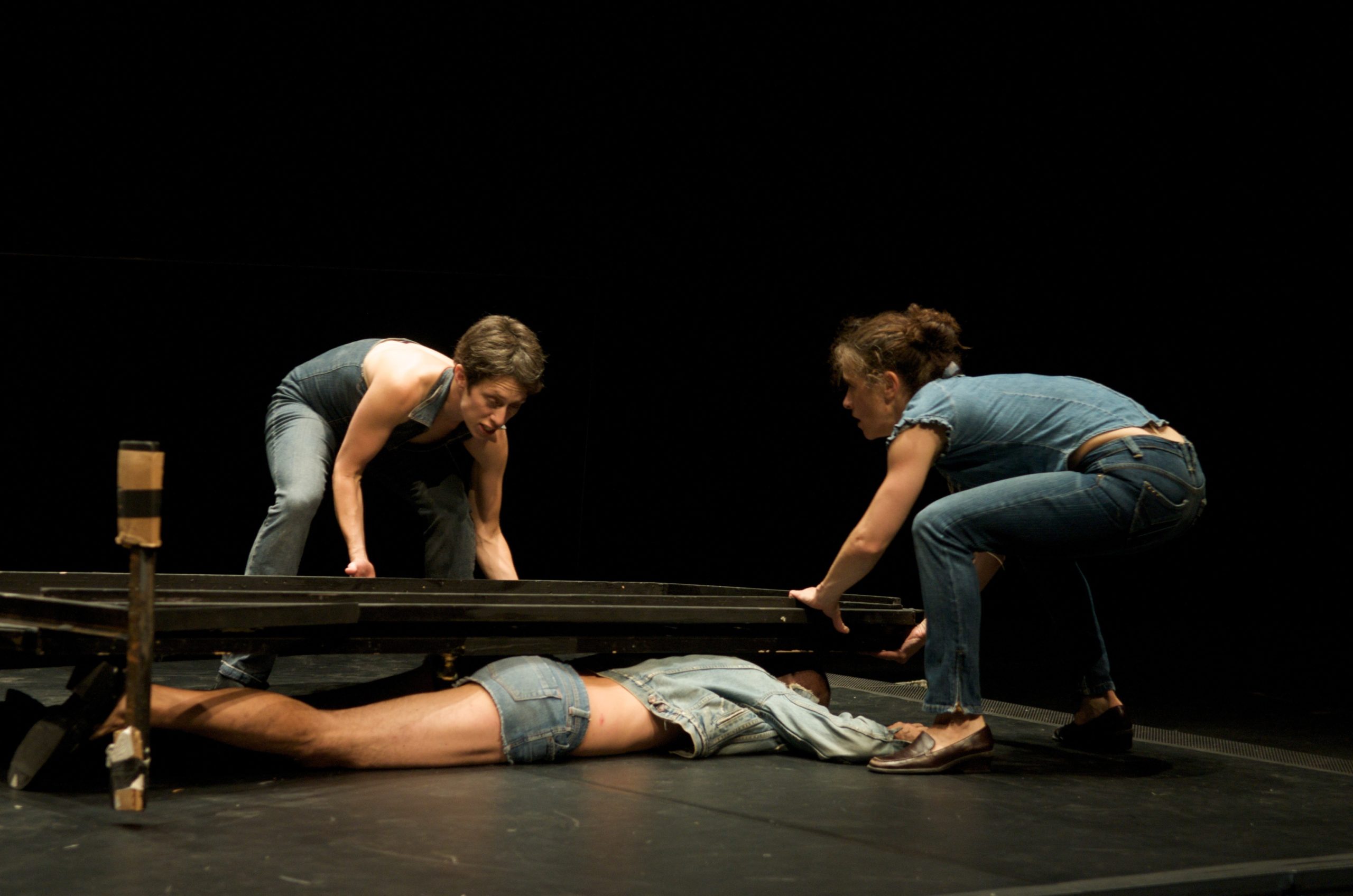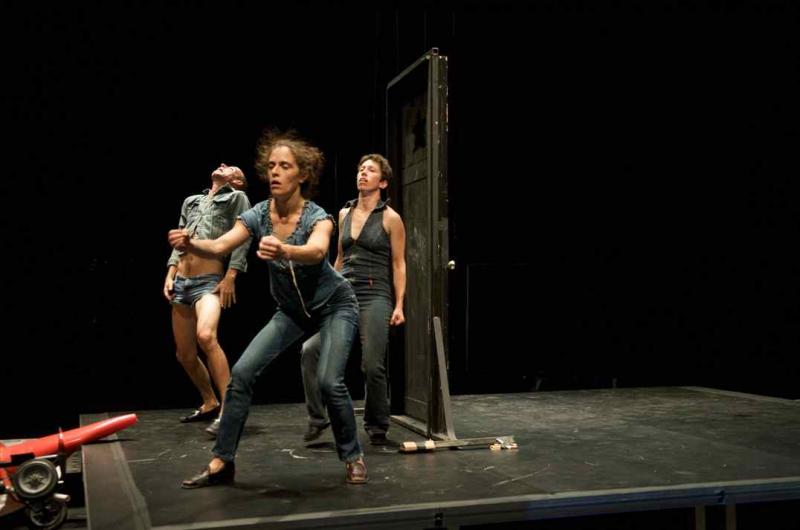Returning to “Smithsoniansmith”
Lightsey Darst responds to "Smithsoniansmith" by Hijack and Heron, recently on stage at Open Eye Theatre. She first saw the show last fall and revisits it anew here - in the process making a persuasive case for re-viewing such performance, in general.


LAST FALL I WROTE ABOUT A FIRST VIEW of Hijack (local duo Kristin Van Loon and Arwen Wilder) and Heron’s (Scott Heron, of New Orleans) Smithsoniansmith, with a promise to revisit the show this year. Last weekend, Hijack and Heron remounted Smithsoniansmith at the Open Eye Figure Theatre, and I went.
First, I should start by making the case for revisiting, in general — rereading, re-seeing, returning. After all, in our forward-propelled, news-saturated culture, any backward glance seems retrograde, even stupid. If you waste time rereading an old book, you won’t have time to check out the latest smash; you’ll be uncool, and then defensive about your uncoolness. To not be current — that’s a serious risk to run. And it’s worth looking into motives: a reactionary fear of the new can certainly underlie return.
But I hold that anything worth engaging with once is worth revisiting. (I use the word “engage” to leave aside light entertainments that merely scratch an itch.) Never to return would be like always knowing other people glancingly, as an acquaintance, never deeply, intimately. Intimacy reveals not only the individual differences we might call personality, but also the underlying humanity — and under that, the utter differences that make individuals separate. Intimacy reveals not only the other, but the self. The difference from acquaintance to intimacy is not quantitative, but qualitative.
Let me go on a little: haven’t you ever found yourself, on a second look or a longer encounter, liking something you initially didn’t get or perhaps even disliked? Experience has taught me always to return to whatever inspires strong dislike; I know I can learn from it. In your return to a work of art, you can begin to sort out the substance of the work from its effect on you, and to enjoy the interplay between them. You can even revisit your own past self — the self who first read or saw or heard. Sometimes it’s humbling to confront past misunderstandings, but acceptance and even clemency are inherent in the act. I’d go so far as to argue that revisiting is a vital part of our ongoing moral education.
Fine and good, but revisiting dance? Painters, poets, architects — they can assume return. The first reading of a poem often indicates only its outline; no one would claim to know a painting on a single brief viewing. (Leave aside those people who race through museums, photographing famous works.) But, generally, we pay little or nothing to revisit these works, and we can encounter them however we like, just in passing or deeply, searchingly, backwards or forwards. In dance, though, you buy your ticket, and sit and watch. Any choreographer who assumes the luxury of later, closer looks is apt to find himself with an empty house.
And choreographers largely make dances that yield pleasurable and rich first viewings, Hijack and Heron included. But many choreographers, Hijack and Heron in particular, also work in such layers that second and even third viewings will keep offering new experiences. Besides, Hijack often makes work through multiple versions and viewings, and Smithsoniansmith is specially intended for the second look: last year’s version was labeled “as is” and this year’s is “this is it”. They aren’t identical.
Beyond the case for reviewing this work and other similarly complex and ever-evolving choreographies, though, I want to say something further about looking again at dance. There’s a lot more to say here — about the economics of remounting work, the effects of venue and casting changes, the way works can sometimes be, yes, diminished by our memories of them — but I want to zero in on something at once more esoteric and more visceral: memory for dance.
Dances moves us because it moves us: because, literally, we feel the movement of the dancers in our own nervous systems. This is true when the movement is subtle as well as when it’s obviously virtuosic. But we’re mostly not trained in the apprehension of movement. Even dancers, seeing a step for the first time, can’t always understand how it’s formed. Revisiting engrains the movement path, expands our movement knowledge, makes us actually more physical, more a part of our felt and feeling world.
______________________________________________________
“An edge of danger” doesn’t convey this show’s throwing, slamming, crushing. Either this iteration of Smithsoniansmith is riskier than before or I tamed it in my memory, muted its extremes, because alongside the violence is a spirit of adoration, practically worship.
______________________________________________________
ENOUGH PERSUASION. But before I get to my second viewing, let me recall my first. As a critic, I usually give a fresh opinion; I don’t have the luxury of letting a work sit before I speak. However useful and newsworthy these responses may be, they leave out something essential: we go to see art not only for the instant of experience, but for the lasting change. So what do I remember?
A lot of building and destroying — cheeky and funny, mostly, as Hijack and Heron tend to be, but with an underlying edge of danger. The constructions so feverishly erected, so quickly condemned — what’s behind this rage for building, this destructive creativity that strews so much wreckage in its wake?
All that building makes me think of the construction project that currently impinges most upon my consciousness, as it must the consciousness of half the Twin Cities dance community — the Shubert Theater. Whatever anyone felt about the project — mistrust about its effect on the dance scene, disbelief that it would ever be built, awe at the insanity of moving such a big building, curiosity, excitement — has been replaced by simply dealing with its physical presence. Construction has closed the sidewalk, so numerous dancers going to class at the neighboring Hennepin Center for the Arts now jaywalk in the adjoining lane, passing close by big dozers and buses. The racket of drilling, sandblasting, and whatever else finds its way into every class. You can see the titanic cranes and drills from half the HCA windows. I keep thinking that we should react in some way to the monumental stone-and-mortar drama outside the window, but so far, in Minnesota Dance Theatre’s advanced/professional ballet class, we don’t; we continue our finely articulated footwork and delicately modeled arms as if nothing were happening.
Outside the dance world, construction/destruction has some other obvious connections — the rash of important local building projects in the last ten years, the 35W bridge collapse and reconstruction, the aftermath of Hurricane Katrina (Heron lives in New Orleans), even 9/11. All these events preceded Smithsoniansmith — but in my mind they seem to come after it, giving the piece, in my memory, a prescience. Perhaps the new work of art rearranges not only all other art objects, as T. S. Eliot says, but all events as well.
I also remember some snapshots, the movement memories I cited above. In the opening nude scene, I remember Van Loon in a lunge, coyly wiggling a branch, athletic and innocent. I remember Heron’s antic physicality, his loose scarecrow limbs. I have a borrowed memory, too: someone else told me how cherubic Wilder looked as she poured black ooze down a wall (hello, oil spill — more prescience). I don’t know whether I saw this for myself, but it’s now one of my memories of Smithsoniansmith.
Does that sound like not much to recall from an hour-long performance? Maybe, but I saw it nine months ago. And these memories aren’t pallid. When I recollect them, it’s as if I am enacting them; I can feel my body preparing for them. They are a part of my lived experience.
NOW THAT WE’RE READY — what did I see the second time around?
More violence. “An edge of danger” doesn’t convey this show’s throwing, slamming, crushing. Either this iteration of Smithsoniansmith is riskier than before or I tamed it in my memory, muted its extremes, because alongside the violence is a spirit of adoration, practically worship. I remember the building and destroying, but now Smithsoniansmith goes beyond reference to some primal force, the twinned impulse to create and to wreck. The performers seem like new animals in a new world, or survivors of a catastrophe, as they use and misuse whatever they find (taking a glove for a sock, nylons for a bra, etc). As they explore, building a world from scraps, we relive our own basic impulses — and discover how anarchic they are (so often wanting a thing and its opposite), and how that anarchy holds the seeds of both war and love.
But that’s enough theorizing. What can you really say about art like this? My theories, past and present, are fine, but there’s always something persistently inscrutable to be found in work worth returning to. Some of our pleasure comes from figuring out the score, certainly, understanding the underlying, but some also comes from not knowing. Ultimately, Smithsoniansmith remains irreducible. The more you see it, the more you experience it; the episodes are not replaced by their meanings. And the more you experience it the less you need to reduce it to a meaning. Instead, you begin to want to react with creativity — material creativity and creativity of understanding. You want to make, to trace, to see.
A last thought —
It’s funny how you can forget something you liked, and remember something you don’t understand. It’s a mystery what attaches. You must go back, you must keep going back, to learn who you are, why any one thing matters to you and any other does not…
______________________________________________________
Noted performances:
Smithsoniansmith (this is it), by Hijack and Scott Heron, was on stage at Open Eye Figure Theatre June 24 – 27.
The first iteration of Smithsoniansmith was onstage at Bedlam Theatre, September 12 & 13, 2009. You can read Lightsey’s review, a first look at the show, here.
______________________________________________________
About the author: Originally from Tallahassee, Lightsey Darst is a poet, dance writer, and adjunct instructor at various Twin Cities colleges. Her manuscript Find the Girl has just been published by Coffee House; she has also been awarded a 2007 NEA Fellowship. She hosts the writing salon, “The Works.”